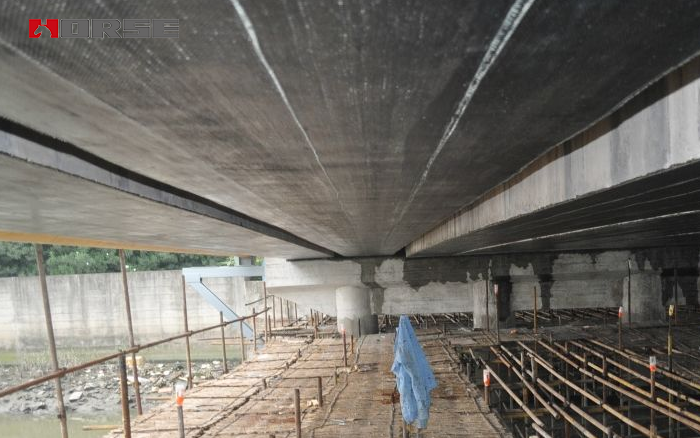Puente de vigas de hormigón reforzado con CFRP
Rehabilitación de puentes
El CFRP y la barra de refuerzo soportan la carga juntos, lo que reduce la tensión de la barra de refuerzo, de modo que la estructura ha logrado el efecto de fortalecimiento y refuerzo. Se cree que el refuerzo de fibra de carbono se convertirá en la tendencia inevitable del refuerzo de puentes en el futuro.

Principio de la estructura de hormigón reforzado con CFRP: cuando se utiliza una resina especial para unir la tela de fibra de carbono a la superficie de tracción de la estructura de hormigón, la tela de fibra
de carbono y la estructura original forman una nueva totalidad de tensión. El CFRP y la barra de refuerzo soportan la carga juntos, reduciendo la tensión de la barra de refuerzo, de modo que la estructura
ha logrado el efecto de fortalecimiento y refuerzo.
Las principales características de la tecnología de unión de refuerzo de fibra de carbono son:
El peso de la estructura y el tamaño de la sección apenas aumentan.
No cambia la altura libre debajo del puente;
Fácil de construir;
Casi no daña la estructura original.
Tiene buena resistencia a la corrosión, durabilidad y resistencia a la fatiga.
Excelentes propiedades mecánicas, se puede utilizar de manera efectiva para una variedad de refuerzo estructural, incluyendo flexión, cizallamiento, compresión, fatiga, sismo, resistencia al viento, control
de grietas y expansión por deflexión, aumenta la ductilidad de la estructura, según el análisis de la fuerza puede ser refuerzo de unión multicapa, su dirección también puede ser de agarre flexible.
Además, la textura de la fibra de carbono es suave, no puede cambiar la forma de la estructura bajo la premisa de reforzar una variedad de estructuras de hormigón, después del refuerzo se puede recubrir
con mortero de hormigón, o el patrón requiere pintar una variedad de pigmentos, reparar y reforzar sin dejar rastros.
Métodos de refuerzo y refuerzo con láminas de CFRP:
Refuerzo de flexión, lámina de fibra de carbono adherida al lado de tracción;
El refuerzo de corte se puede hacer pegando verticalmente en ambos lados de la viga o formando una envoltura de anillo en forma de U en la parte inferior, lo que equivale a aumentar los estribos de corte.
La resistencia a las grietas se refuerza y se pega a lo largo de la dirección vertical de las grietas.
El elemento de compresión del núcleo de la columna se refuerza y el anillo central de la columna se une.
Se refuerza la pared de corte y las láminas de fibra de carbono se pegan a lo largo de las paredes de corte en uno o ambos lados a lo largo del refuerzo de corte.
El efecto del refuerzo de fibra de carbono es notable, pero se deben tener en cuenta los siguientes problemas en las obras de refuerzo de puentes reales. El entorno y las condiciones de construcción de la fibra de carbono son muy diferentes a las del laboratorio, y el rendimiento de construcción del propio material afecta a la calidad de la construcción, por lo que la resistencia a la tracción de diseño de la fibra de carbono debe reducirse considerablemente con respecto a los datos de laboratorio. El nivel tecnológico del equipo de construcción también es un factor que afecta a las propiedades mecánicas de los materiales compuestos, pero aún no se trata de una evaluación cuantitativa. En la actualidad, es científico y razonable definir los factores que influyen en la resistencia de diseño de la fibra de carbono mediante el método de coeficiente parcial, pero los valores específicos de estos factores deben determinarse de acuerdo con una gran cantidad de datos experimentales y análisis teóricos científicos.
Conclusión
A través del estudio continuo de los materiales de fibra de carbono y la mejora continua de los métodos de refuerzo de fibra de carbono, se cree que el refuerzo de fibra de carbono se convertirá en la
tendencia inevitable del refuerzo de puentes en el futuro.